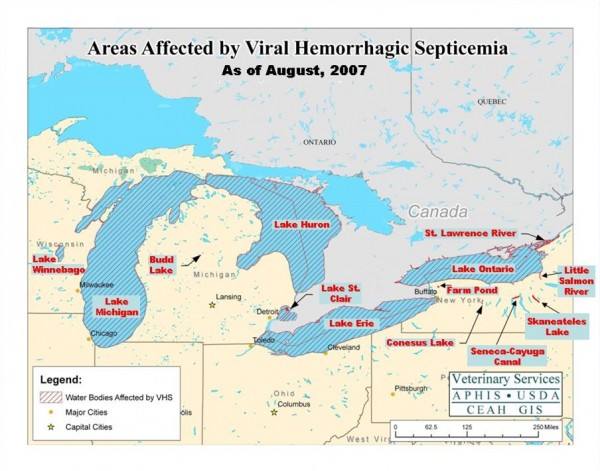Egtved virus caused marine mass death in Northern hemisphere
A virus likened to the human Ebola virus, because it makes fish bleed to death, has been identified as the mystery agent that caused thousands of dead fish to clog up Milwaukee harbor last month.
The Wisconsin Department of Natural Resources (DNR) announced on 1 April that the shoals of gizzard shad, Dorosoma cepedianum, had died of viral hemorrhagic septicemia (VHS).
Viral hemorrhagic septicemia (VHS) is a deadly infectious fish disease caused by the Viral hemorrhagic septicemia virus (VHSV, or VHSv). It afflicts over 50 species of freshwater and marine fish in several parts of the northern hemisphere. VHS is caused by the viral hemorrhagic septicemia virus (VHSV), different strains of which occur in different regions, and affect different species. There are no signs that the disease affects human health. VHS is also known as “Egtved disease,” and VHSV as “Egtved virus.”
Historically, VHS was associated mostly with freshwater salmonids in Western Europe, documented as a pathogenic disease among cultured salmonids since the 1950s. Today it is still a major concern for many fish farms in Europe and is therefore being watched closely by the European Community Reference Laboratory for Fish Diseases.
It was first discovered in the US in 1988 among salmon returning from the Pacific in Washington State. This North American genotype was identified as a distinct, more marine-stable strain than the European genotype. VHS has since been found afflicting marine fish in the northeastern Pacific Ocean, the North Sea, and the Baltic Sea.
Since 2005, massive die-offs have occurred amongst a wide variety of freshwater species in the Great Lakes region of North America. Fish virologists at the DNR say that after regularly causing die-offs in at least 25 species in the Great Lakes since it first hit in 2003, the disease hadn’t struck since 2008.
They believe VHS vanished because fish that survived the first outbreaks became immune to it. But fish born more recently would not have had any exposure and would therefore lack immunity, causing another die-off. The DNR researchers think this is what happened in Milwaukee.
“The gizzard shad infected with VHS in March were hatched in the summer of 2010, and so were naive to the virus,” says Susan Marcquenski of the DNR. Because the lakes are so large, die-offs may occur undetected, but the spectacular and unexpected deaths in the harbor made it easier to identify and diagnose. (NewScientist)


Commenting rules and guidelines
We value the thoughts and opinions of our readers and welcome healthy discussions on our website. In order to maintain a respectful and positive community, we ask that all commenters follow these rules.